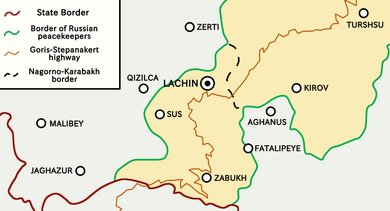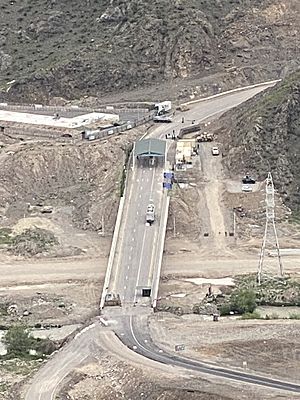Lachin corridor facts for kids
The Lachin corridor is a mountain road that connects Armenia and Nagorno-Karabakh. It's the only road between these two areas. Because of this, many people call it a "lifeline" for those living in Nagorno-Karabakh. The corridor is in the Lachin District of Azerbaijan. However, a Russian peacekeeping force is supposed to control it. This was agreed upon in the 2020 peace agreement.
Until 2022, the corridor included the villages of Zabukh, Sus, and the city of Lachin. On August 26, 2022, these places were given back to Azerbaijan. Four days later, a new road opened to the south. This new route goes around Zabukh, Sus, and Lachin. Instead, it passes near the villages of Mets Shen/Boyuk Galadarasi and Hin Shen/Kichik Galadarasi.
On April 23, 2023, Azerbaijani officials set up a checkpoint on the corridor. They said it was to stop "illegal" transport of military supplies and natural resources. However, Armenia and Artsakh said this was not true. The 2020 peace agreement does not say the corridor can only be used for humanitarian aid. Many countries and groups have criticized Azerbaijan's ongoing blockade of the Lachin corridor. They see it as breaking the peace agreement. This agreement promised safe movement along the corridor in both directions.
Contents
History of the Lachin Corridor
Early Blockades and Opening the Road
During the First Nagorno-Karabakh War, Artsakh and nearby Armenia faced a blockade. This started in August 1989. Azerbaijan cut off transport and trade links between Armenia and Azerbaijan. They also cut links between Artsakh and Armenia. Later, Turkey joined this blockade to support Azerbaijan.
Artsakh was completely cut off from the outside world for three years. This lasted from August 1989 to May 1992. Then, the Artsakh Defence Army opened a special path. This path became known as the Lachin corridor. It allowed humanitarian aid to reach Armenia.
The Corridor After the 2020 War
The Second Nagorno-Karabakh War ended with a peace deal. Russia helped to make this agreement in 2020. After this, the Lachin corridor became the only way to connect Armenia and Nagorno-Karabakh.
The peace agreement stated that Armenia would return the Lachin District by December 1, 2020. The agreement also said:
The Lachin corridor (5 km (3.1 mi) wide) will connect Nagorno-Karabakh to Armenia. It will go around the town of Shusha. This corridor will stay under the control of Russian peacekeepers. The countries will agree on a plan to build a new route for the Lachin corridor within three years. This new route will also link Nagorno-Karabakh and Armenia. After it's built, the Russian peacekeepers will move to guard this new route. Azerbaijan promises to keep traffic, people, and goods safe along the Lachin corridor in both directions.
After the peace deal, about 200 Armenians stayed in the Lachin corridor. About 30 were in Sus, 100 to 120 in Lachin, and over 40 in Zabukh. The president of Azerbaijan, Ilham Aliyev, said a new corridor would be built. This is because the current Lachin corridor goes through the city of Lachin. Once the new corridor is ready, the city of Lachin will return to Azerbaijani control.
On August 26, 2022, Azerbaijan took control of the Lachin District. Artsakh officials told people in the villages along the corridor to leave their homes. They had 20 days to move out. While Aliyev promised that Armenians living in Lachin for a long time would be treated as citizens, he called others "illegal settlers." He demanded they leave. A new corridor was to be built as part of the peace agreement. Russian peacekeepers would also control this new road. Some experts think Azerbaijan might not allow electricity, gas, and internet lines along the new road.
In March 2021, a journalist from the BBC visited the road. They reported that Armenians no longer controlled who used the road. The Russians were in charge now. This road is the only link between Nagorno-Karabakh and Armenia. It is often called a "lifeline" for the people living in Nagorno-Karabakh.
What Happened After the 2020 War
In August 2022, Azerbaijan finished building its part of the new road around Lachin. Armenia had not yet finished its part. On August 2, local Armenian officials said that Azerbaijan wanted them to use a different road to connect with Armenia. This new road would go around the existing one. After new fighting around Lachin in August 2022, Armenia's Security Council Secretary, Armen Grigoryan, said Azerbaijan's demand was against the law. He said Armenia had not agreed to any plan for a new road yet.
Azerbaijan accused Armenia of delaying the building of its part of the road. They said their part was already done. On August 4, Armenia's Minister of Territorial Administration, Gnel Sanosyan, said work on the new road was active. He expected it to be finished by spring 2023. On August 5, Armenian officials told people in Lachin, Zabukh, and Sus to leave their homes by August 25. After this date, the towns would be given to Azerbaijan. Some Armenian residents burned their houses before leaving. By August 26, Azerbaijan had control of the villages in the Lachin corridor. This included Lachin, Sus, and Zabukh. Soon after, the new road to the south opened. It passes by the villages of Mets Shen/Boyuk Galadarasi and Hin Shen/Kichik Galadarasi.
The Situation Today
Since December 12, 2022, people from Azerbaijan, who say they are "eco-activists," have blocked the Lachin corridor. This has left 1,100 people, including 270 children, unable to go home. After this, Azerbaijan cut off the gas supply from Armenia to Nagorno-Karabakh. This happened between December 13 and 16. This put the 120,000 Armenian residents of Nagorno-Karabakh at risk of a serious humanitarian problem.
Many countries have spoken out against the blockade. These include France, Greece, the Netherlands, Russia, and Canada. The issue is also being discussed by the Parliamentary Assembly of the Council of Europe.
On April 26, 2023, Russia's Defense Ministry announced a change. Aleksandr Lentsov was appointed to lead the Russian peacekeeping forces. He replaced Andrei Volkov. Before 2020, Lentsov was a deputy commander in the Russian Army. This change happened shortly after Azerbaijan set up its checkpoint on the road.
See also
 In Spanish: Corredor de Lachín para niños
In Spanish: Corredor de Lachín para niños
- Lachin offensive



